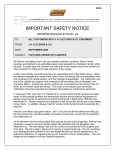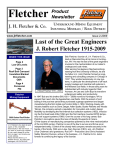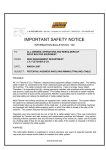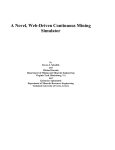Download Issue 1 - JH Fletcher & Co.
Transcript
Fletcher Product Newsletter J. H. Fletcher & Co. www.jhfletcher.com Inside Page 2 Hydraulic Pressure Adjustments Continued Page 3 Pre Cleaner Skirts Vacuum Page 4 Vacuum Continued Your E-Mail Newsletter on the Web The Fletcher Product Newsletter can be downloaded from www.jhfletcher.com. From the home page, click on Product Newsletters. Select the year and the issue you would like to download and click on the link. You will need Adobe Acrobat Reader to view the newsletter. Huntington, WV 2003 Issue 1 ROOF BOLTER HYDRAULIC PRESSURE ADJUSTMENTS A roof drill must be viewed as a collection of systems, all of which must be operating properly in order for the machine to operate with maximum safety and efficiency. The hydraulic pressures are but just a part of one of the systems - the hydraulic system. Attempting to compensate for other issues by increasing the hydraulic pressure can be a dangerous approach. Pressure settings, depending upon the machine function to which they relate, are intended to 1) maintain a safe working hydraulic pressure for the operator, and 2) protect machine components, drilling tools and the mine roof from excessive forces. Inappropriate or excessive pressure settings can result in damage to the machine or drilling tools, not to mention serious operator injury or even death. One of the most common problems associated with “pressure” is an understanding of what creates pressure in a hydraulic system. Pressure is created by the restriction of flow. There must be flow available from the pump before pressure can be created. The majority of Fletcher roof drills use gear type pumps. These pumps develop a fixed flow output regardless of pressure. As the pump wears, the ability of the pump to develop rated flow at high pressure is reduced. This results in a reduction in power output to the hydraulic motor or cylinder being operated. Although the static pressure output of the system may be high, the corresponding volume output can be almost zero. Hence, if the pump is worn, simply raising the pressure setting will not actually increase the overall output of the circuit. But it can create a circumstance where, for instance, the drill thrust could exceed safe limits causing the steel to bend or break. Also, if a new pump is installed without reducing the relief valve setting, the pump could be damaged. There are three important things to consider before making any pressure adjustment: KNOW WHAT YOU ARE ADJUSTING KNOW WHY YOU ARE MAKING THE ADJUSTMENT KNOW WHAT THE CORRECT PRESSURE SETTING SHOULD BE Additionally, consider other factors that could be affecting machine performance before attempting any pressure adjustment. Some of these factors would include the following: Page 2 J. H. Fletcher & Co. A. PUMP CONDITION As pointed out earlier, if the pump is worn the actual power output to the circuit being operated will be reduced. Although it may be possible to increase the static pressure setting, this will not result in any improvement in operation and can result in serious safety hazards. B. HYDRAULIC OIL LEVEL If the hydraulic oil level is low this will result in heating, which will reduce pump and component efficiency. In extreme cases cavitation will occur, causing pump and component damage. Cavitation will result in foaming of the hydraulic oil. C. CONDITION OF HYDRAULIC OIL Contaminated hydraulic oil will result in premature hydraulic component failure. Always use the fill pump system (manual or powered) when adding hydraulic oil. Never pour hydraulic oil into the machine through the breather cap opening. If the hydraulic oil has been contaminated with water, the oil will have a milky appearance. D. FILTER CONDITION Dirty pressure line filters will create additional pressure loss in the system creating heat and reducing system effectiveness. If the return line filters are dirty, this will create excessive backpressure, again resulting in diminished system operation. Clogging of the suction strainers (located in the hydraulic tank) will starve the pumps and possibly lead to cavitation. E. MECHANICAL SYSTEM - BINDING, ALIGNMENT AND LUBRICATION If the system being operated, for instance the drill feed or rotation, is not properly lubricated, maintained or adjusted, a considerable amount of the power available to the system can be expended in simply overcoming these problems resulting in overall reduction in drilling ability. Drill head alignment is particularly important on arm feed style machines. F. DUST COLLECTION SYSTEM OPERATION 2003 Issue 1 The most important thing to remember when troubleshooting or adjusting the drilling system is that the hole cannot be drilled any faster than the dust can be removed from the hole. Drilling rate (speed) is directly related to the efficiency of the dust suppression system. Always check the dust suppression system for proper operation before making any drilling system hydraulic adjustments. Clogged hoses, leaks and dirty dust filters, worn blowers or vacuum relief valves, will seriously affect dust suppression system operation. G. CONDITION OF DRILLING TOOLS DRILL STEELS AND BITS As with the dust suppression system, the condition of the drill steels and bits can seriously affect drilling efficiency. Make sure bits are sharp, properly ground (if re-used) and drill steels are not bent, cracked or broken. Also, try to minimize the use of multiple drill steels. Proper pressure settings are essential for safety. Some of the hazards associated with incorrect pressure settings include the following: A. Drilling System: Bending or breaking of drill steels can endanger the operator resulting in serious injury or death. B. Stabilizing Foot: Setting the stabilizing foot with excessive pressure can create a situation where the driller canopy can strike the operator when the foot is retracted. This has been discussed in Fletcher Information Bulletin 67, which is available on line at www.jhfletcher.com or by contacting our Risk Management Department at (304) 525-7811. C. ATRS System: If the ATRS pressure is set too low, the accumulator will not be sufficiently charged during setting to provide oil pressure for maintaining roof contact. If the pressure is set too high, the system can exert excessive pressure against the roof causing a possible dislodgment of roof material. Page 3 J. H. Fletcher & Co. Information concerning pressure settings and machine maintenance and adjustment can be found in the Service Manual. Keep in mind if you are having problems identifying a circuit, the machine hydraulics may have been modified or non-OEM replacement components may have been used, 2003 Issue 1 which could affect how the machine operates and expose your operator to a potentially unsafe piece of equipment. Additional information can be obtained by contacting our Risk Management Department. PRECLEANER SKIRTS Pre-cleaners have become a popular option on Fletcher roof bolters. They minimize the frequency of servicing the dust box, thereby making the overall system more efficient. In order to keep the pre-cleaners from being damaged, they are mounted relatively high on the machine. Depending on conditions, the dust falling from the pre-cleaner could make a cloud and be re-introduced into the mine air. In order to help minimize this situation, precleaner skirts have been developed. The skirt fits all Fletcher precleaner designs. The kit can be ordered in a 14” length (part number: 56363 & 56221 or a 28” length (part number: 56364 & 56221). To attach the kit to the pre-cleaner the operator should install the kit so that the rubber skirt is not dragging on the ground, this could suck water or dirt into the dust system. We encourage you to look at this as another way to control your operator’s exposure to dust. Even if you have a machine mounted higher than 28”, the rubber can be cut to length upon special request. To order, call your Fletcher authorized parts distributor or J.H. Fletcher & Co. Skirt Have you checked your vacuum lately? The dust collection system used by J.H. Fletcher & Co. has passed a MSHA performance test. The MSHA approval incorporates all the individual dust components into a certified system. The vacuum setting used for testing is based on blower performance (check your parts manual for your specific blower). This vacuum setting is stamped on the dust approval tag that is usually located in the tram deck. This is the minimum vacuum that can be used with the dust approval. If the blower wears to the point that it cannot maintain this pressure, it must be replaced. You are required to use only genuine Fletcher parts to maintain your dust collection system. The importance of proper vacuum settings: 1. Less respirable dust: cuttings are properly removed from the hole during the drilling cycle creating a safer work environment. Continued on page 4 J. H. Fletcher & Co. Page 4 2003 Issue 1 Continued from page 3 2. Increased production: removing dust more effectively increases drill penetration rate, resulting in fewer bit changes and faster cycle times. 3. PN# 132121 Vacuum Pressure Gauge Your E-Mail J.H. Fletcher & Co. appreciates you sending us E-mail and answering our web site survey. However, if you are sending in E-Mail requests, we ask that you provide us the following information: NAME , A FULL ADDRESS, PHONE NUMBER, AND YOUR E-MAIL ADDRESS. PLEASE ADDRESS YOUR E-MAIL TO: [email protected] The information contained in this newsletter has been obtained from sources believed to be reliable, and the editors have exercised reasonable care to assure its accuracy. However, J. H. Fletcher & Co. does not guarantee that contents of this publication are correct and statements attributed to other sources do not necessarily reflect the opinion or position of J. H. Fletcher & Co. Published by J. H. Fletcher & Co. Box 2187 Huntington, WV 25722-2187 c 2002 J. H. Fletcher & Co. Box 2187 Huntington, WV 25722-2187 (304) 525-7811 Longer bit life: The bit stays cooler thus increasing drilled footage and lowering bit usage. *Note: Check your complete dust collection system at recommended intervals, as outlined in the Fletcher maintenance manual, to keep your system operating at an effective level of operation. Also empty dust collection boxes at proper intervals to keep them from getting overfilled. To assist in checking the vacuum, Fletcher offers a vacuum gauge (left) that is placed in the drill chuck. the part number for the gauge is 132121. Currently we are only sending the Fletcher Newsletter to a select readership. If you know of someone in your company who wishes to be placed on our mailing, please let us know. Below is a form for a free subscription to the newsletter. Just fill out the form and return it to J. H. Fletcher & Co., Risk Management, Box 2187, Huntington WV 25722-2187. FREE SUBSCRIPTION FORM Name_________________________ Job Title_________________ Company_____________________ Address__________________ City _______________________ State _____ Zip _____________ Phone ______________________










